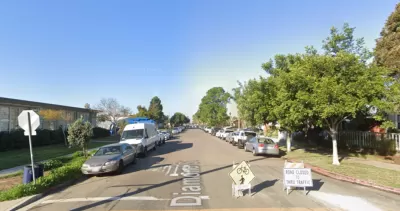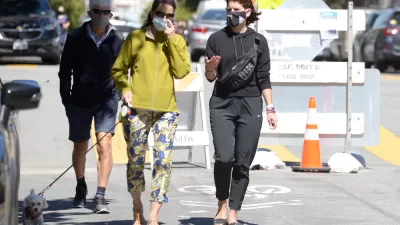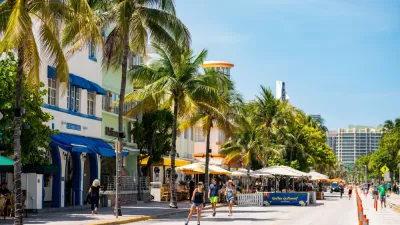Residents in Pacific Beach want the city to revise its design of the Diamond Street ‘slow street,’ the last remaining segment of pandemic-era pedestrian-oriented road in the city.

“San Diego’s controversial two-year experiment with ‘slow streets’ suffered another setback this week when Pacific Beach leaders demanded major changes to the only slow street segment that had been popular enough to survive,” reports David Garrick.
“Pacific Beach leaders say the benefits of having a new safe space to exercise and strengthen bonds among neighbors was outweighed by the city’s poor rollout of the program, confusion about the rules and poor treatment of residents.” According to planning group member Scott Chipman, “We need a comprehensive plan, not just the city throwing a couple signs out to say this street is now a park and you residents have to deal with it.”
“Wednesday’s hearing featured 16 speakers in favor of the slow street and 16 speakers against, said [Marcella Bothwell, leader of the Pacific Beach Town Council], suggesting the experiment could work with some upgrades and different behavior from users of the slow street.” While some residents brought up disrespectful behavior from the street's users, some opponents worry that Diamond Street would receive the same controversial bike lane treatment as Gold Coast Drive. “On Mira Mesa’s Gold Coast Drive, city officials did some re-striping in early April that created new bike lanes on either side of the road, with one vehicle lane in the center to handle car traffic in both directions.” But the design confused and angered some residents who felt the city didn’t provide enough notice and who feared an increased risk of head-on collisions.
Opposition to the city’s ‘slow streets’ implementation isn’t always just about drivers. “Community leaders in San Ysidro wanted a more permanent paseo instead of a slow street segment,” for example. “City officials say the program has taught them what works, what doesn’t work and how to cooperate with residents and neighborhood leaders on future slow streets projects. But the recent uproar in Mira Mesa raises questions about that.”
FULL STORY: San Diego’s only surviving ‘slow street’ facing new backlash, demands for safety upgrades

Alabama: Trump Terminates Settlements for Black Communities Harmed By Raw Sewage
Trump deemed the landmark civil rights agreement “illegal DEI and environmental justice policy.”

Study: Maui’s Plan to Convert Vacation Rentals to Long-Term Housing Could Cause Nearly $1 Billion Economic Loss
The plan would reduce visitor accommodation by 25% resulting in 1,900 jobs lost.

Planetizen Federal Action Tracker
A weekly monitor of how Trump’s orders and actions are impacting planners and planning in America.

Waymo Gets Permission to Map SF’s Market Street
If allowed to operate on the traffic-restricted street, Waymo’s autonomous taxis would have a leg up over ride-hailing competitors — and counter the city’s efforts to grow bike and pedestrian on the thoroughfare.

Parklet Symposium Highlights the Success of Shared Spaces
Parklets got a boost during the Covid-19 pandemic, when the concept was translated to outdoor dining programs that offered restaurants a lifeline during the shutdown.

Federal Homelessness Agency Places Entire Staff on Leave
The U.S. Interagency Council on Homelessness is the only federal agency dedicated to preventing and ending homelessness.
Urban Design for Planners 1: Software Tools
This six-course series explores essential urban design concepts using open source software and equips planners with the tools they need to participate fully in the urban design process.
Planning for Universal Design
Learn the tools for implementing Universal Design in planning regulations.
Caltrans
Smith Gee Studio
Institute for Housing and Urban Development Studies (IHS)
City of Grandview
Harvard GSD Executive Education
Toledo-Lucas County Plan Commissions
Salt Lake City
NYU Wagner Graduate School of Public Service





























